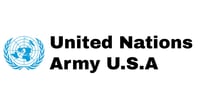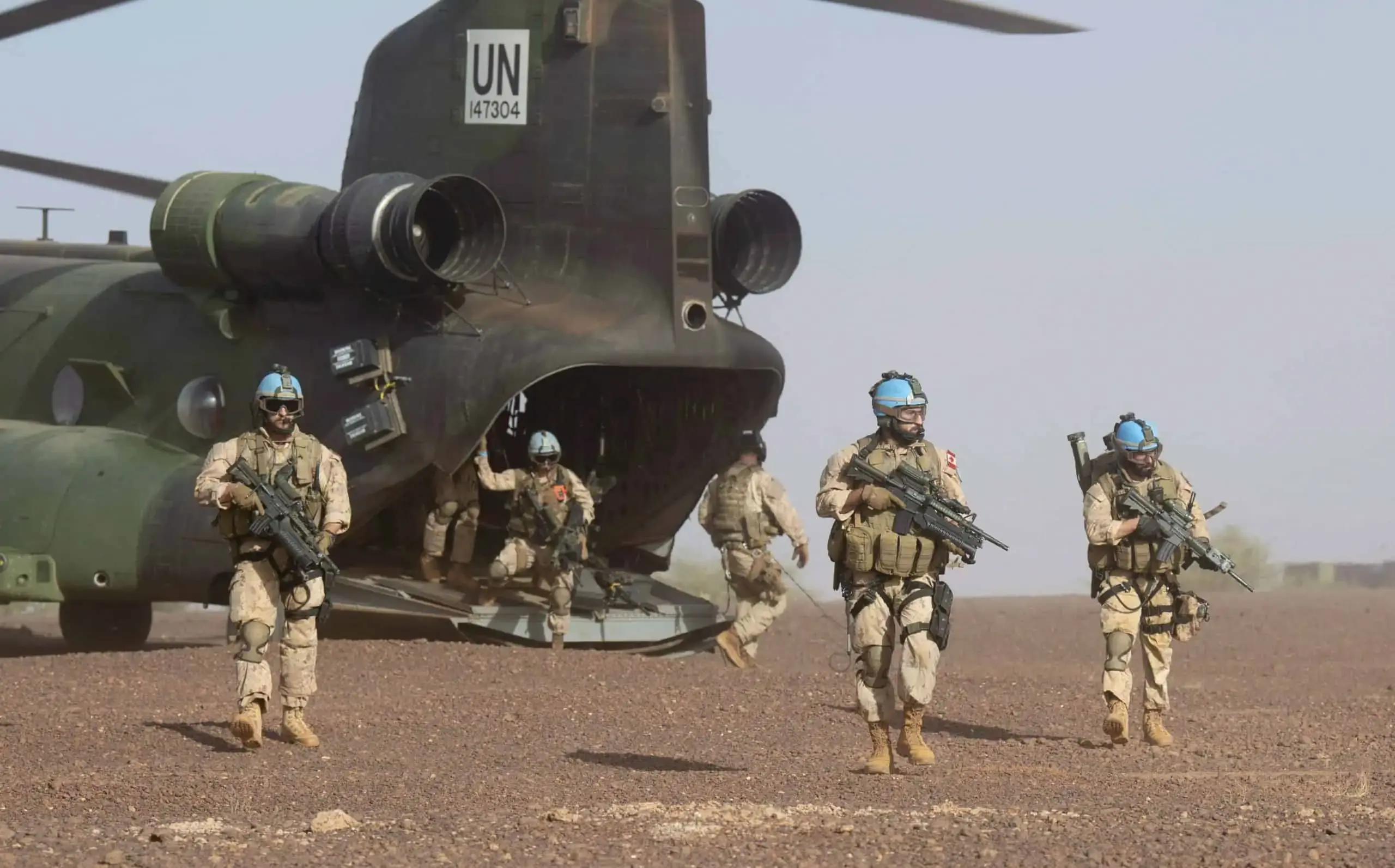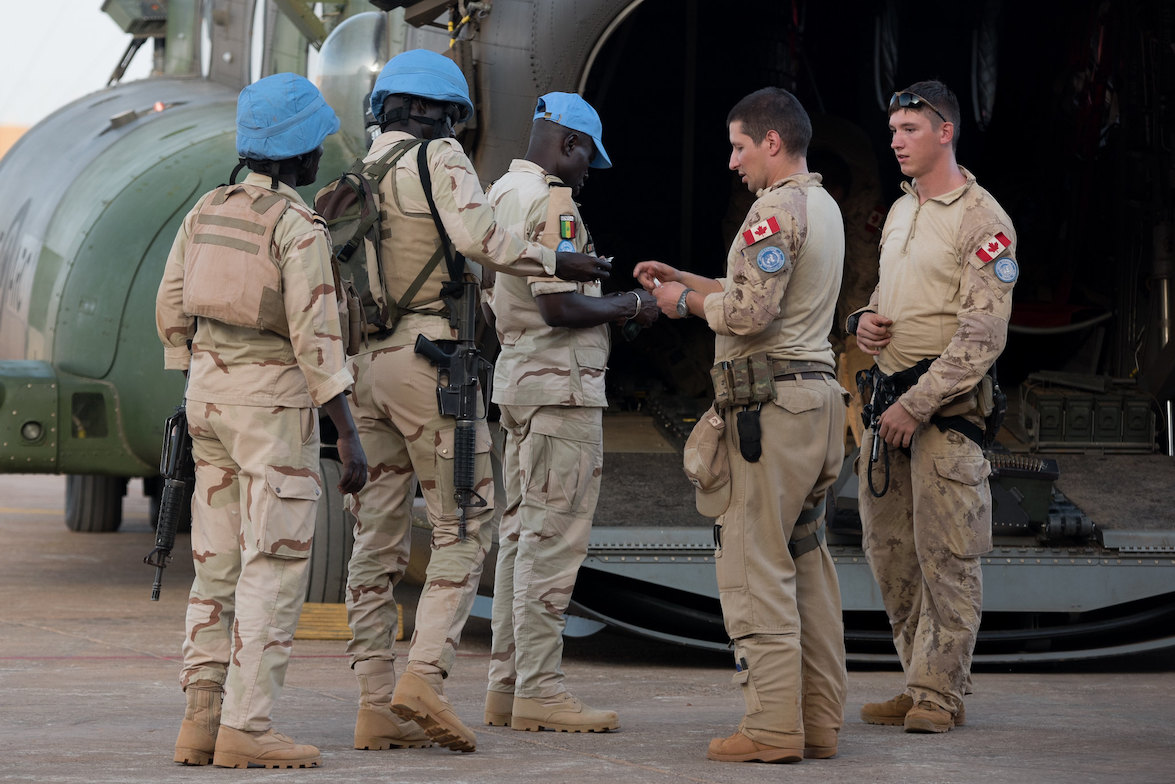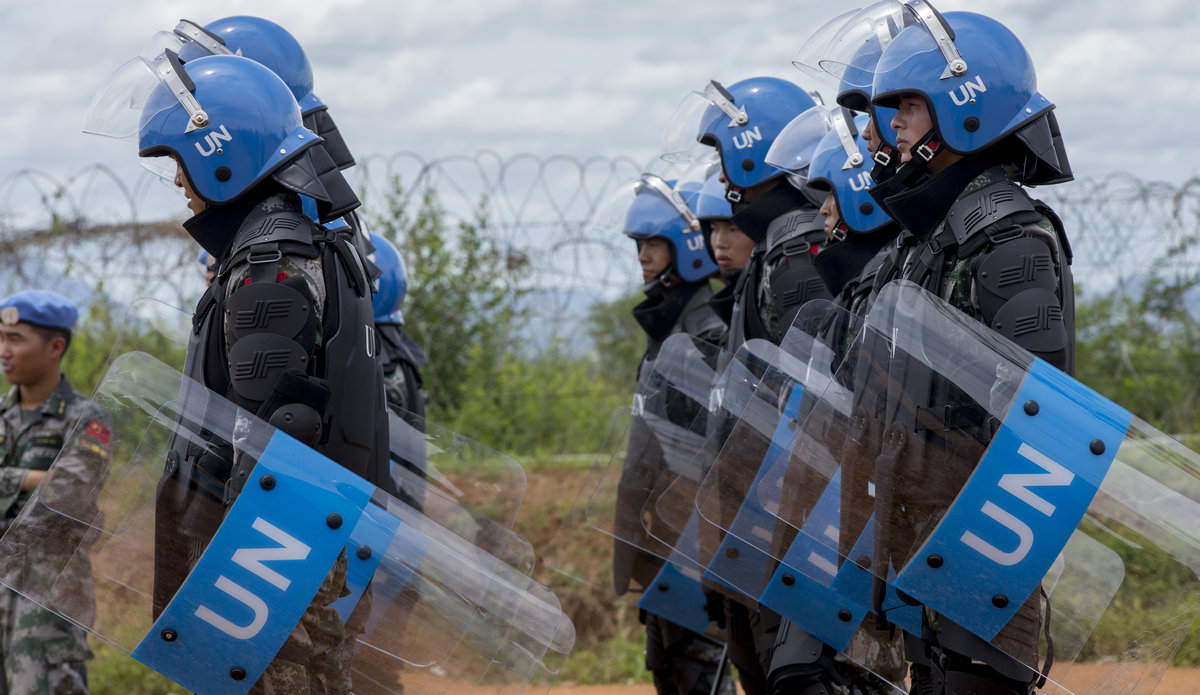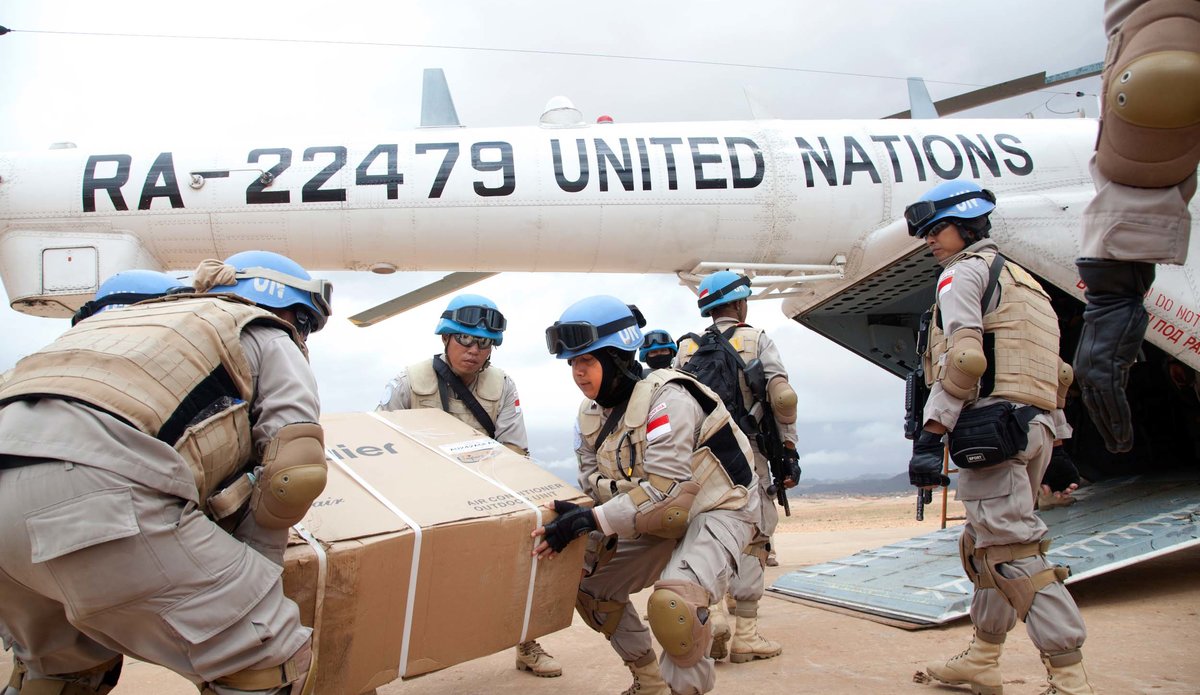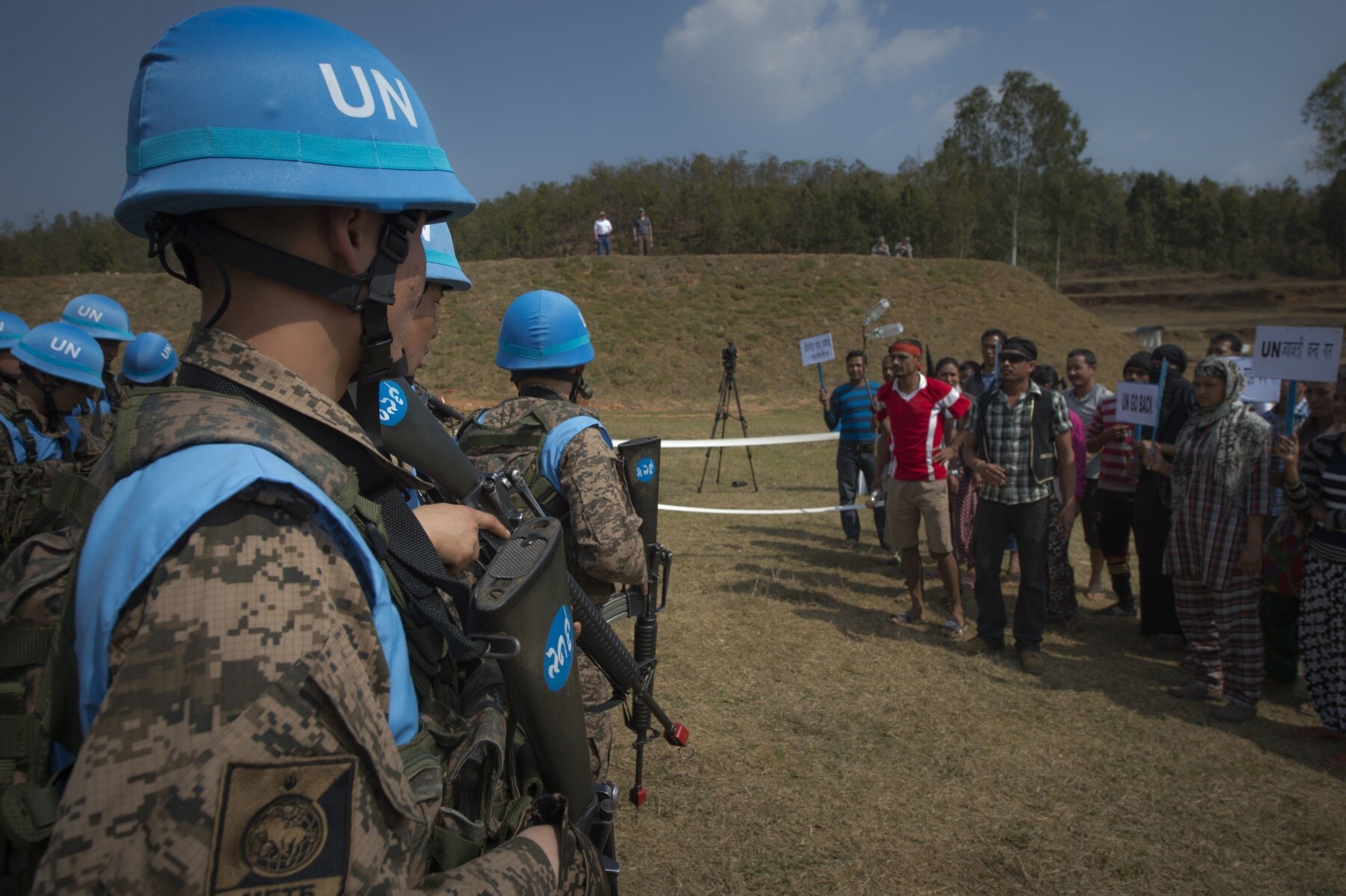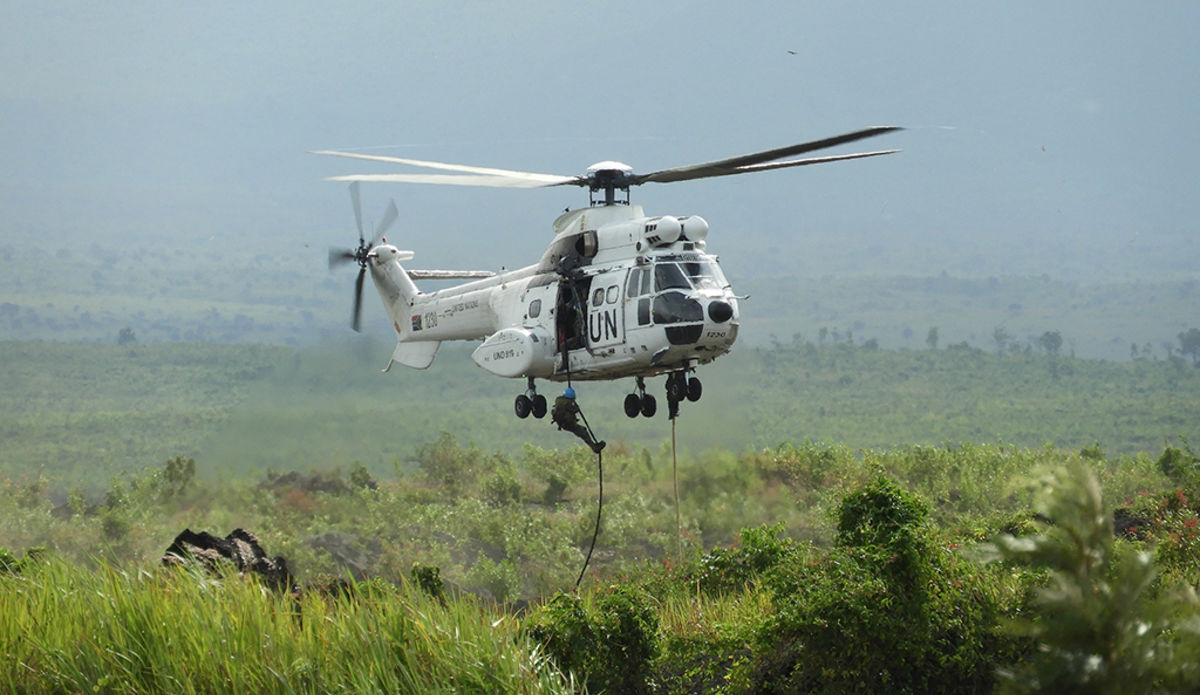The United Nations Army (USA) military personnel are the Blue Helmets on the ground. Today, they consist of about 60,000 military personnel contributed by national armies from across the globe.
We work alongside UN Police and civilian colleagues to promote stability, security, and peace processes; we protect personnel and property; we work with local communities, and security forces promote lasting peace.
In many missions, protection of civilians is at the heart of our mandate. Blue Helmets are protecting populations against threats and contributing to a secure environment.
It is essential that we increase the representation of female military in UN peacekeeping operations.
Global contribution for global peace
All military personnel working under the Blue Helmet are first and foremost members of their own national armies and are then seconded to work under the command and control of the UN.
We have around 60,000 UN uniformed personnel coming from over 120 countries. They come from nations large and small, rich and poor. They bring different cultures and experience to the job, but they are united in their determination to foster peace. Currently, the majority of troops come from African and Asian countries, while the contribution of western countries is increasing.
What UN military personnel do
The UN has been deploying military personnel for service in peace operations since 1948 when the Security Council authorized the deployment of UN military observers to the Middle East to monitor the Armistice Agreement between Israel and its Arab neighbours.
UN military personnel can be called upon to:
- Protect civilians and UN personnel;
- Monitor a disputed border;
- Monitor and observe peace processes in post-conflict areas
- Provide security across a conflict zone;
- Provide security during elections;
- Assist in-country military personnel with training and support
- Assist ex-combatants in implementing the peace agreements; they may have signed.
One of the biggest changes UN Peacekeeping has seen over the 75 years of its existence has been the increasingly multi-dimensional nature of UN peacekeeping operations. UN military peacekeepers are often deployed in inhospitable, remote and dangerous environments where they face an unprecedented scale of challenges especially when protecting civilians, under asymmetric threats.
Getting involved
The United Nations Office of Military Affairs seeks highly qualified military officers from UN Member States for service in our peace missions around the world, either as individual Staff Officers, as Military Observers, or as part of a formed unit from an individual Troop-Contributing Country. Staff Officers are also valued at UN Headquarters from where they support all aspects related to the deployment of troops on the ground. By the end of 2024, 8.2 per cent of UN military personnel in contingents were women. A top priority for UN Peacekeeping is to increase the number of female military personnel in peacekeeping operations, including increasing women staff officers and military observers to 25 per cent by 2028; by the end of 2025, 23.29 per cent of staff officers and military observers in peacekeeping operations are female.
Blue Helmets as members of their own national armies are seconded to work with the UN for periods normally of up to one year in the field, or two or three years at UN headquarters. Any queries about working for the UN in a military capacity should be addressed within an applicant's own country first.
What kind of Blue Helmets are needed?
The most common sort of UN peacekeeper is the infantry soldier. However, increasingly we need specialized personnel who we refer to as ‘enablers’. These skilled soldiers include engineers, who for example were able to help with the post-earthquake reconstruction in Haiti, or the building of new roads in South Sudan. We also need helicopters and their crews, as they enable us to extend our area of influence and be much more visible. Other specialist enablers include transport companies, communicators and medical personnel.
Modern peacekeeping operations are often very complex, and place high demands on the personnel we deploy. High levels of training are required before deployment, and the UN works closely with Troop-Contributing Countries to provide the best help and advice possible. Troops must know what to do if they find themselves in an ambush, for example, and must be capable of responding appropriately.
Blue Helmets Performance Standards
To implement their mandated tasks, our troops need to prepare adequately, starting sometimes far before deployment. This preparation covers every aspect of UN Peacekeeping such as ensuring the availability of the necessary and proper equipment. It is also critical that peacekeepers are properly trained, to name a few, in Protection of Civilians, the use of force, and the Rules of Engagement. Also, a thorough understanding of conduct and discipline is a key training requirement.
- Policies on readiness, performance, command and control.
- Protection of Civilians (POC) Implementing Guidelines for military component in peacekeeping missions (February 2015) provide clear objective for military component when it comes to POC.
- Rules of Engagement: This document provides authority for the use of force and explains policy, principles, procedures and responsibilities relating to the use of force. For each mission, specific rules of engagement are drafted.
- Our troops in the field are required to implement their mandate with utmost professionalism, dedication and dignity, often at significant personal sacrifice. Unfortunately, Blue Helmets have been accused of acts of misconduct, including sexual exploitation and abuse. These reprehensible acts are an affront to the values of protection that UN Peacekeeping upholds. All acts of misconduct are unacceptable and forbidden.
Does the UN have a standing reserve Force?
It takes considerable time to deploy troops and we are often asked why we do not have a standing reserve.
The UN can only deploy military personnel when there is a UN Security Council resolution authorizing them to do so. The Security Council will say how many military personnel are required, and UN Headquarters will liaise with the Member States to identify personnel and deploy them. This can take time – often more than six months from the date of the resolution to get boots and equipment on the ground.
As former UN Secretary-General Kofi Annan said, the UN is “the only fire brigade in the world that has to wait for the fire to break out before it can acquire a fire engine.” A standing reserve sounds logical, but it would be immensely costly to have a force of several thousand people on permanent standby. Although it takes time, it is much more practical to generate the military personnel once the go-ahead has been given. This also ensures we recruit personnel with the appropriate background, training and language skills relevant to the place they are being deployed to.
With these limitations in mind, since 2015 the UN has been working with Member States to develop a new arrangement called the Peacekeeping Capability Readiness System (PCRS). Through the PCRS, Member States can pledge to have specific units available for UN Peacekeeping. Far in advance of a possible deployment, the UN Secretariat will perform an assessment of the readiness of the personnel, training, and equipment of those units. Select units can also be pledged to the Rapid Deployment Level of the PCRS and will be made available within 60 days of a request from the UN Secretary-General. When fully operational at the start of 2018, this system should help reduce the deployment timelines of military forces for future mission start-ups.
%20AIRBORNE.jpeg?width=2048&height=1365&name=UN-ARMY%20(USA)%20AIRBORNE.jpeg)
Peacekeeping Capability Readiness System
The UN Peacekeeping Capability Readiness System (PCRS) aims to establish a more predictable and dynamic process of interaction between the UN Headquarters and Member States for strengthening readiness and timely deployment of peacekeeping capabilities with the right qualities.
There are four levels of readiness in PCRS:
-
Level 1: A Troop Contributing Country makes a formal pledge for a unit and provides the list of major and self-sustainment equipment and certification of completion of basic training and human rights screening. Member States are encouraged to include the time frame of availability and duration of deployment for each pledged capability.
-
Level 2: Based on the UN operational requirements, pledges at Level 1 can be elevated to Level 2 after an assessment and advisory visit has been conducted by a UN Headquarters team.
-
Level 3: Following a satisfactory assessment, units which have achieved a reasonable degree of preparedness are elevated to Level 3.
-
Rapid Deployment Level (RDL): Having reached Level 3, the Troop Contributing Country may pledge to deploy within 60 days following a request made by the UN Headquarters.
Around 9,000 civilians and United Nations Volunteers now serve in United Nations peacekeeping operations around the world. As peacekeeping operations have become more multi-dimensional, the need for specialized civilian skills is ever in demand.
Civilian staff members perform many of the mandated tasks of peacekeeping operations: promoting and protecting human rights, helping strengthen the rule of law, fostering political and reconciliations processes, promoting mine-awareness, and serving as public information officers who explain and build support for the peace processes and the work of the United Nations.
Civilians also serve in many support capacities in the areas of finance, logistics, communication and technology (ICT), human resources and general administration to help missions promote peace and security.
Civilians serve as either international staff or as national staff hailing from the host country, but also as United Nations Volunteers, consultants or contractors.
Working to ensure the UN is accountable and addresses failures to protect civilian populations and pursues accountability and disciplinary actions when peacekeepers sexually exploit or abuse the very populations they are deployed to protect.
Peacekeeping contributors must reinforce their commitment to uphold a zero-tolerance policy for sexual exploitation and abuse. To support this accountability effort, in 2018, we began working with the UN to fund and coordinate the first joint U.S.-UN National Investigation Officer (NIO) course to train the officers who investigate conduct and discipline issues, including allegations of sexual exploitation and abuse against military personnel serving with an UN peacekeeping operation. We continue our support for the NIO course, with seven iterations conducted over the last two years, including participants from 33 countries in the Africa, Latin America, and Indo-Pacific regions.
Female peacekeepers
It is an operational imperative that we recruit and retain female peacekeepers to achieve gender equality. Gender equality contributes to lasting peace as women and men experience, engage in and are affected by violent conflict differently which causes different understandings of peace. Increasing the number of women peacekeepers will encourage women from the countries we operate in to participate in public life and help dismantle harmful stereotypes and assumptions that impede women’s ability to play a central role in public life, including in peace-building processes.

Women in Peacekeeping: A Key to Peace – and a U.S. Priority
We work to ensure women’s priorities are central to peace and security decisions at all levels. To achieve this goal, we address social, cultural and political barriers and protection risks that limit women’s full participation in achieving and sustaining peace.
Women around the world play a critical role in preventing conflict, building peace and helping countries recover during crises, often putting their own lives at risk. Despite this, women largely remain at the periphery of formal peace processes and decision-making.
Our priority is to change the status quo by putting women’s priorities and rights at the heart of peace and political processes and to achieve gender equality in peacekeeping operations. We work with partners, including civil society and communities, to address social, cultural and political barriers and protection risks that limit the full participation of women.
The Department of Peace Operations (DPO) is at the forefront of advancing the Women, Peace and Security (WPS) agenda. We are mandated by the UN Security Council to implement WPS Resolutions, which recognize the disproportionate and unique impact of armed conflict on women and girls and acknowledge the contributions they make to conflict prevention and resolution, peacekeeping and peacebuilding. Further, the Security Council highlights the importance of the equal and full participation of women as active agents in peace and security and addresses the impact of sexual violence in conflicts.
Our work is guided by the Secretary-General’s Action for Peacekeeping Initiative (2018), and his Call to Action “Women Transforming Peace and Security” (2020), which reaffirm that women’s full, equal and meaningful participation in peace processes, political solutions and peace operations, as well as gender-responsive efforts, are essential for effective peacekeeping.
What strategies can increase women’s participation in peacekeeping?
The United Nations Army-USA Peacekeeping advocates for the deployment of more women. Security Council Resolution (SCR) 1325 on Women, Peace and Security was a landmark resolution that addressed, for the first time, the disproportionate and unique impact of armed conflict on women. It recognized the under-valued and under-utilized contributions women make to conflict prevention, peacekeeping, conflict resolution and peacebuilding. UN Peacekeeping has used SCR 1325 and additional resolutions to implement the Women, Peace and Security agenda and increase the number of women peacekeepers.
The Secretary-General launched a Gender Parity strategy in 2017 to reach gender parity among senior UN leaders by 2021 and across the UN system by 2028. This strategy sets the tone and guidance for efforts to increase numbers of women in civilian and uniformed roles in peacekeeping. Gender parity and diversity in leadership teams brings important perspectives and enables missions to engage a broader section of the population. It is imperative that UN Peacekeeping recruits and retains women peacekeepers who have made a positive impact on peacekeeping environments, both in supporting the role of women in building peace and protecting women’s rights.
Equal and inclusive peacekeeping contributes to lasting peace. The barriers to women’s leadership in peace efforts are persistent and addressing them requires multiple and sustained actions.

Around the world and throughout history, wars adversely and disproportionately affected women and girls, yet women remain under-represented in efforts to prevent and resolve conflict, as well as in post-conflict peace-building. We recognize the diverse roles women play as agents of change in preventing and resolving conflict, countering terrorism and violent extremism, and building post conflict peace and stability. Studies repeatedly demonstrate full and meaningful participation of women in peace operations, especially in leadership positions, widens perspectives on conflict management, opens doors for more inclusive political resolutions, and ultimately improves international peacebuilding strategies. There is also evidence of direct correlation between the meaningful participation of women in peacekeeping and the performance and effectiveness of peacekeeping units
More women in peacekeeping leads to more effective peacekeeping. Working closely with like-minded countries and the UN to develop and deliver training and drawing on the expertise of civil society organizations, United Nations Army-USA (UNA-USA) is making tangible contributions toward international peace and security. UNA-USA continues to promote women, peace, and security as an important means of improving accountable and operational effectiveness in peacekeeping.

UN Peacekeepers serving for peace, sacrificing for humanity
Peacekeepers serving under the UN flag work in difficult and dangerous environments, risking their lives to protect some of the world’s most vulnerable people. Since 1948, more than two million women and men have served as UN peacekeepers. Every day, they make a tangible difference in the lives of millions of the world’s most vulnerable people, and every day they save lives. In places like the Central African Republic and South Sudan, our peacekeepers protect civilians against violent attacks and support the delivery of crucial humanitarian assistance. They provide security, stability and hope for a better future to war-affected communities. And they often do so at great personal risk and under very harsh conditions, leaving their families behind thousands of hundreds of miles away from their homelands. More than 4,400 peacekeepers have lost their lives serving under the UN flag.
Making a difference
Today, UN peacekeepers hail from more than 100 troop and police contributing countries, but they are united in their goal to help provide security and stability to some of the most vulnerable people on earth. Collectively, they perform acts of courage and compassion every day.
Beyond their regular mandated activities – such as protecting civilians and supporting peace processes -- peacekeepers often carry out humanitarian efforts such as delivering free medical and veterinary care, providing access to water; supporting schools and orphanages; building roads and bridges and other key infrastructure which benefit communities and bring people together.
The United Nations honors the service and sacrifice of all peacekeepers and commends the contributions from all the countries that provide our peacekeeping operations with military and police personnel.
Their stories of service and sacrifice as well as courage and compassion are worth listening to.
UN Peacekeeping has evolved significantly as a tool of international crisis response and proven itself an essential instrument for global peace and security over the past 75 years.
UN peacekeeping operations around the world today illustrate the wide range of mechanisms, strategies and resources that the United Nations marshals in support of peace and security. Over the past two decades, UN peacekeepers have deployed into increasingly difficult and complex environments. Armed conflicts are becoming more intractable. They are compounded by a confluence of new security threats and challenges such as the weaponisation of technology, the climate crisis, displacement of populations, and proliferation and fragmentation of non-state armed groups. These factors pose ever greater hurdles to ending violence and achieving sustainable peace.
These multifaceted threats, amplified by mis- and disinformation directed against the UN in some settings, has caused a rise in attacks against peacekeepers. Missions have sometimes lacked the personnel and equipment to meet these threats. Peacekeeping operations have also faced challenges in delivering on protection mandates and in contributing to long-term, sustainable peace, and in achieving coherence with other actors operating in the same contexts. In order to remain relevant amid this evolving landscape, a number of actions are being taken by the UN in partnership with Member States to reform peacekeeping so that it can remain fit for purpose and meet today’s challenges.
Implementation of Shared Commitments
The Declaration of Shared Commitments has reached over 150 endorsements and provides a shared roadmap for strengthening peacekeeping. Success depends on Member States and the UN Secretariat working actively to implement their commitments.
We, in the Secretariat, are implementing our Declaration commitments by focusing on a set of key priorities that build on both new commitments and existing workstreams. Implementation goals are centered on eight priority commitment areas:
- politics
- women, peace and security
- protection
- safety and security
- performance and accountability
- peacebuilding and sustaining peace
- partnerships
- conduct of peacekeepers and peacekeeping operations
These eight priority commitment areas are anchored in ongoing areas of work, including the Gender Parity Strategy; the Women, Peace and Security Agenda; Santos Cruz Action Plan; Management Reform; Police Strategic Guidance Framework; Strategic Force Generation; the United Nations/African Union Joint Framework and Declaration; the Triangular Partnership Project; the Voluntary Compact on the commitment to eliminate sexual exploitation and abuse; the Human Rights Due Diligence Policy and the Environment Strategy. A tracking system is in development so that progress can be systematically monitored and reviewed.

Mine action makes it possible for peacekeepers to carry out patrols, for humanitarian agencies to deliver assistance and for ordinary citizens to live without the fear that a single misstep could cost them their lives.
Mine action entails more than removing landmines from the ground. It includes high impact efforts aimed at protecting people from danger, helping victims become self-sufficient and active members of their communities and providing opportunities for stability and sustainable development.
The objective of mine action is to identify and reduce the impact and risk of explosive hazards to a level where people are safe.
UNA-USA coordinates the mine action work of the UN system as Chair of the Inter-Agency Coordination Group on Mine Action (IACG-MA), comprising the twelve UN offices, specialized agencies, funds and programmes.
The International Day for Mine Awareness and Assistance in Mine Action is commemorated on 4 April each year. Events take place around the world including in UN missions, information centres and the UN offices in Bangkok, Geneva, Nairobi and New York.
On this day the UN reaffirms its commitment to a world free from the threat of mines, explosive remnants of war (ERW), including cluster munitions, and improvised explosive devices (IEDs). The theme of 2020 is “Together for Mine Action.”
Get involved and donate to the mine action work of the United Nations.
UN Global Advocate for the Elimination of Mines and Explosive Hazards
On 14 April 2015, the UN Secretary-General Ban Ki-moon designated the renowned actor Daniel Craig as the first UN Global Advocate for the Elimination of Mines and Explosive Hazards at the UN Headquarters in New York.
Treaties
The UN mine action work is guided by a solid framework of international law, including the Anti-Personnel Mine Ban Convention, the Convention on Cluster Munitions, the Convention on Certain Conventional Weapons, and the Convention on the Rights of Persons with Disabilities.
Building partnerships
UNAUSA administers the Voluntary Trust Fund for Assistance in Mine Action, which was established in 1994 by UN Member States as a single entry point to fund mine action work. UNAUSA continues to build new partnerships with traditional and non-traditional donors including individuals, private corporations and foundations.
Safe Ground Campaign
In 2019, the Secretary-General of the United Nations launched the five-year Safe Ground campaign to turn minefields into playing fields. Safe Ground is a global advocacy and fundraising campaign supported by an informal, voluntary Group of Champions, comprised of Member States of the United Nations, United Nations entities, civil society organizations, sports federations, private sector companies, and individual athletes.
The campaign tackles two essential and linked challenges: clearing explosive hazards to make the ground safe for people to return and rebuild their communities without fear of injury or death and raising awareness and resources to support those who have acquired a disability because of explosive hazards. Since its launch, Safe Ground projects have started in Afghanistan, Cambodia, Cyprus, the Democratic Republic of the Congo, Iraq, Liberia, the State of Palestine, Somalia, and Vietnam.
Rule of law is at the heart of peace and security and longer-term development
Strengthening the rule of law and essential criminal justice services is one of the critical tasks of UN Peacekeeping to prevent conflict and lay the foundations for sustainable peace.
Equipped with justice and corrections expertise, and with support from the Justice and Corrections Service (JCS), peacekeeping missions assist host countries to deliver essential justice and prison services, strengthen criminal justice systems, and facilitate rule of law reforms. They do so by promoting accountability for serious crimes that fuel conflict, extending justice and corrections institutions in conflict-affected areas, and by enhancing prison security and management, including to help mitigate and address emerging crisis, such as the impact of the COVID-19 pandemic.
From its Headquarters in New York, the Justice and Corrections Service (JCS) coordinates strategic and operational support on mandate delivery, strengthening Member States’ support, leveraging partnerships and setting policy priorities. It supports the work of peacekeeping operations and special political missions as well as other United Nations entities, to implement the rule of law aspects of their respective mandates.
Through its rapid response team – Justice and Corrections Standing Capacity in Brindisi, Italy, JCS provides field-based advice and specialized expertise to field missions and other field presences. Established in 2010, JCSC assists United Nations peace operations and other field presences by means of three core functions: Starting up Justice and Corrections components; Reinforcing existing peace operations and presences in the areas of justice and corrections by providing time-limited and targeted support; and Conducting needs assessments and reviews in the areas of justice and corrections.
Our work
Justice and corrections components work closely with national authorities to promote and prioritize the peaceful resolution and prevention of disputes, to strengthen the protection of civilians, to improve national security and restore and extend the authority of the State, restore trust and social cohesion, and to contribute to the implementation of peace agreements.
